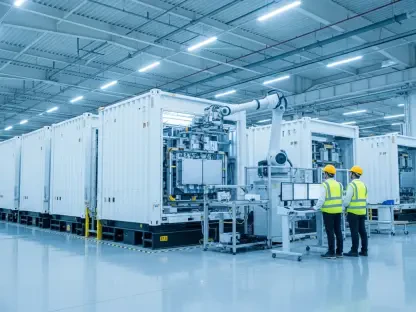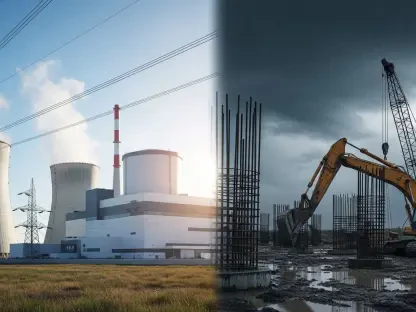The global implications of the United States’ withdrawal from the Paris Climate Agreement under the Donald Trump administration have sparked significant debate. This decision, seen as a setback for global climate efforts, presents unique opportunities for developing nations to take the lead in sustainable development.
The US Retreat and Its Global Impact
A Shift in Global Leadership
The United States, historically one of the largest carbon emitters and the largest economy, stepping back from the Paris Agreement creates a paradoxical situation where their retreat is considered a setback, but it also opens avenues for other nations to accelerate their climate action plans. This development leaves a vacuum in global leadership in climate policy, providing other countries with the chance to step up and fill the gap. The world needs innovative solutions, and this shift in leadership could inspire new strategies from developing nations, allowing them to pursue aggressive environmental goals that align with sustainable development.
The U.S. exit from the Paris Agreement illustrates a broader trend of declining American influence in global environmental policy. As the country turns inward with “America First” policies, its failure to adapt to a rapidly decarbonizing world becomes more evident. This could result in diminished influence on international platforms, encouraging other nations to create resilient, independent climate strategies. Emerging economies are demonstrating that they can turn challenges into opportunities, setting ambitious targets for clean energy and collaborating internationally to build a more sustainable future. Their proactive measures might set new standards in global climate efforts, showcasing the benefits of transitioning towards renewable energy sources.
Opportunities for Developing Nations
Developing nations now find themselves at a pivotal moment, with the chance to adopt a proactive stance in green energy and technologies. The increasing accessibility and affordability of these technologies, largely due to China’s leadership, enable these nations to pursue green development independently of the United States. As renewable energy options become more viable, countries in the Global South can leapfrog traditional fossil fuel-based development, thus reducing their carbon footprint and contributing significantly to global climate goals. This momentum can foster economic growth, create jobs, and drive innovation in sustainable practices.
Countries like India and Brazil are already making significant strides in renewable energy, demonstrating that economic development and climate action can coexist and reinforce each other. Additionally, collaboration within the developing world can lead to shared expertise and resources, which can further accelerate the adoption of green technologies. Governments in these nations are often more flexible and can implement reforms faster than their developed counterparts, which can give them a competitive edge. By investing in renewable energy and sustainable infrastructure, developing nations can not only address immediate environmental challenges but also ensure long-term economic and social stability.
China’s Role in Green Technology
China’s Leadership in Renewable Energy
China has emerged as a pivotal player in the renewable energy sector, becoming the largest producer of solar panels, wind turbines, and electric vehicles. This leadership has strategically positioned China as a global leader in renewable energy. By investing heavily in green technology, China has managed to lower costs and increase the scale of production, making renewable energy sources more accessible and affordable around the world. China’s commitment to green technology is evident in its substantial budget allocations for research and development, which aim to further enhance the efficiency and cost-effectiveness of these technologies.
China’s influence in renewable energy extends beyond its borders, as it actively exports its technologies to developing nations. The Belt and Road Initiative, for instance, includes significant investments in renewable energy projects in various countries, helping to build infrastructure and foster economic development. These efforts are not just about economics; they also reflect China’s ambition to be seen as a responsible global leader in the fight against climate change. By sharing its know-how and technologies with other nations, China is aiding in the global transition towards cleaner energy, setting a benchmark for sustainability and environmental stewardship that other countries might follow.
Expanding Influence Through Technology Export
China’s influence extends through the export of green technologies to developing nations. Despite attempts by Western powers to curtail its green technology sector, China’s approach has effectively met the demands for sustainable solutions in the Global South. The strategic export of solar panels, wind turbines, and electric vehicles has not only stimulated global markets but has also empowered developing countries to pursue greener agendas without relying on outdated, polluting technologies. This export strategy is part of a broader geopolitical aim of expanding China’s influence by creating dependencies on its green technology.
Moreover, China’s consistent investment in green technology has disrupted traditional energy markets, leading U.S. companies to reconsider their strategies. As green technologies become mainstream, the reliance on fossil fuels is decreasing, and developing nations are particularly well-positioned to benefit from this transformation. Many of these countries are rich in natural resources like sunlight and wind, which can be harnessed for renewable energy. By adopting Chinese technologies, they can skip the fossil fuel phase altogether. This strategic partnership model also fosters diplomatic ties, creating a network of countries aligned with China’s vision of a sustainable future.
A Call for an Equitable Climate Framework
Critique of the Paris Agreement Implementation
The uneven implementation of the Paris Agreement has come under scrutiny, with developed nations often failing to meet their commitments, especially in providing financial and technological support to developing countries. This shortfall was particularly highlighted at COP27, where advanced nations failed to agree on substantial funding to assist developing countries in their climate transitions. The lack of support hinders the ability of these nations to implement their climate action plans effectively, creating an environment of inequity where the most vulnerable are left to bear the brunt of climate change repercussions without adequate resources.
The critique of the Paris Agreement’s implementation brings into focus the need for a more equitable global climate framework. Developing countries, despite contributing the least to global emissions, face the greatest challenges in adapting to climate change. Their voices are often marginalized in international negotiations, and commitments made by wealthier nations frequently fall short of what is required. Addressing this imbalance requires a concerted effort to reevaluate and reform how climate funds are allocated and utilized. By ensuring that financial and technological support reaches those who need it most, the global community can create a more just and effective response to the climate crisis.
Prioritizing Investments in Renewable Energy
The US retreat offers an opportunity for developing nations to prioritize investments in renewable energy, sustainable infrastructure, and climate resilience. By focusing on these areas, they can reduce their dependence on fossil fuels and drive economic growth in a way that aligns with environmental sustainability. The development of renewable energy projects not only addresses climate goals but also creates jobs, improves public health through reduced air pollution, and enhances energy security. Countries can diversify their energy sources, making them less vulnerable to global oil market fluctuations and geopolitical tensions.
Investing in sustainable infrastructure is equally crucial, as it ensures that new developments are resilient to the impacts of climate change. Building green cities, upgrading transportation networks with electric vehicles, and enhancing public transit systems are essential steps toward a sustainable future. By taking advantage of the current availability and affordability of green technologies, developing nations can leapfrog traditional, carbon-intensive methods of development. This proactive approach not only sets them on a path to economic prosperity but also reinforces their position as leaders in global climate action. Partnerships with international organizations, as well as public and private sector collaboration, can further bolster these efforts.
Innovative Financing Mechanisms
Addressing Funding Shortfalls
The failure of advanced nations to provide adequate financial support necessitates new mechanisms to mobilize resources more effectively. Potential solutions include direct public investment, green bonds, climate funds, and public-private partnerships. Direct public investment can help kickstart projects that might otherwise struggle to find funding, demonstrating government commitment to green initiatives. Green bonds offer a way for investors to contribute to environmentally friendly projects, providing long-term, stable financing. Climate funds, pooled from multiple sources, can target specific areas that need the most support, ensuring that resources are used efficiently and effectively.
Public-private partnerships are particularly promising as they combine the strengths of both sectors. The public sector can provide regulatory support and initial funding, while private companies bring innovation, efficiency, and additional capital. These partnerships can accelerate the deployment of green technologies and infrastructure, making climate projects more viable and scalable. By leveraging the expertise and resources of both the public and private sectors, these innovative financing mechanisms can help bridge the funding gap that has hindered climate action in developing countries. Ensuring that these funds are allocated transparently and effectively is crucial for building trust and encouraging further investment.
Collaborative Efforts for a Sustainable Future
By working collaboratively, nations can create a more equitable and effective global climate framework that does not rely solely on U.S. leadership but instead focuses on equity, innovation, and international cooperation. Multilateral organizations such as the United Nations and the World Bank can play a pivotal role in facilitating these efforts by providing platforms for dialogue, funding, and expert support. Additionally, regional coalitions can foster collaboration among neighboring countries, sharing resources and best practices to tackle climate challenges specific to their areas. The success of these collaborative efforts hinges on the commitment of all parties involved to prioritize sustainable development goals over short-term economic interests.
Moreover, fostering South-South cooperation—partnerships between developing countries—can enhance the exchange of knowledge, technology, and financial resources. These collaborations can enable countries to learn from each other’s experiences and adopt best practices tailored to their unique contexts. Developing a robust framework for international climate action requires a multi-faceted approach, leveraging the strengths and capabilities of nations across the globe. By building synergies and aligning efforts, the global community can ensure that the transition to a sustainable future is inclusive, fair, and resilient against the inevitable challenges posed by climate change.
Embracing a Proactive Approach
Leveraging Global Resources
Most green technologies can now be sourced from countries other than the US, which eliminates the need to rely on the US dollar for financing green initiatives. This shift allows the global community to build a sustainable future using diverse technologies and financial models. By taking advantage of technological advancements from countries like China, Japan, and various European nations, developing countries can implement green solutions that are both cost-effective and innovative. This diversification not only spreads economic risk but also fosters innovation and competition, driving the continual improvement of renewable technologies.
Leveraging global resources also means tapping into international funding sources that are not tied to any single nation’s economic policy. Multilateral development banks, climate funds, and even cryptocurrencies offer alternative financing options that can support large-scale green projects. These resources provide the necessary capital to undertake ambitious initiatives without the constraints imposed by traditional funding mechanisms. By embracing this globalized approach, the world can move towards a more decentralized and resilient financial system that supports sustainable development. This new framework can empower developing nations to take the lead in climate action, showcasing their potential as pioneers in the green economy.
Developing Nations Leading the Way
The global implications of the United States’ decision to withdraw from the Paris Climate Agreement during Donald Trump’s presidency have sparked considerable debate. This move, widely viewed as a setback for international climate initiatives, has had numerous repercussions. Critics argue that it undermines the collective efforts needed to combat global warming and may embolden other nations to slacken their climate commitments. However, this contentious decision also opens up unique opportunities for developing countries to emerge as leaders in sustainable development. These nations can capitalize on this moment to invest in green technologies, create new economic opportunities, and set their own ambitious climate targets. By stepping up to the plate, developing countries have a chance to influence the global climate agenda positively, driving progress and innovation in an area that is critical for the future of the planet. Moreover, their leadership in sustainable practices could serve as a catalyst for change, inspiring other nations to renew their commitments and collaborate more effectively on climate action.









